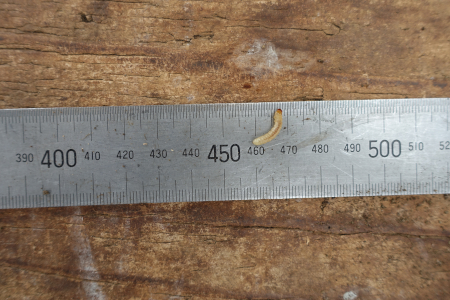Posted on behalf of the Horehound Biocontrol Group
The clearwing moth is established. Or is it?
We thought the clearwing moth was now well established at two sites. One in North Canterbury and one in the Mackenzie Basin. It looked like these populations were ready to start being redistributed to new sites. We were truly excited that the moth established successfully and seemed to have dramatic impact at the sites where it has. We drew up a plan for an intensive redistribution effort. It seemed worth investing resources in an intensive effort because the moth has such a great potential to transform horehound infestations back into pasture so quickly. We were going to use the ‘eggs on toothpicks’ method on a large scale as a one-off. We gathered financial support from an impressive number of catchment groups and other players, applied for funding from MPI, got it provisionally approved, and got going. When we got going, we discovered that the larvae inside the roots of horehound plants at the two site look different. When we consulted about this difference with the experts in Australia, we were told none were the clearwing moth. We got nervous.
Long story short – we did eventually find larvae of the clearwing moth at the Mackenzie site, but at low abundance. Certainly not enough for redistribution yet. You can follow the story of this discovery in this report (PDF 2.0 MB). We will continue investigating this mystery and its implication to using the clearwing moth as a biocontrol agent in NZ.



The focus now shifts to redistributing the plume moth.
The plume moth is established at least at one site in North Canterbury and one in Marlborough, where defoliation was evident on an expanding scale around the release points. We have decided to re-draft the funding application, and put the effort into redistributing the plume moth. The application was successful, and we are grateful to MPI’s SFF Futures and the catchment groups and other partners who made this possible. In September 2022 we will start monitoring the larval development of the plume moth. We expect the larvae will be ready for redistribution in October. The plan is to hold field days for contributing groups and others as much as possible to harvest the precious caterpillars and transfer them to many new sites. Information about field days and numbers that can attend will come closer to the time, but you can note already that they are likely to be around mid-October. We will have to assess first how many releases we can harvest without depleting the source populations (plus other practicality considerations and H&S) before we can determine how many can attend.
Look forward to seeing some of you in October face to face (or rather, mask to mask). Stay safe between floods, power cuts and winter illnesses,
Ronny & Gavin
You can find previous updates by checking the Horehound BioControl page here.
| Dr Ronny Groenteman Senior Researcher – Weed Biocontrol Manaaki Whenua – Landcare Research Phone: +64 3 321 9904 Email: GroentemanR@landcareresearch.co.nz Website: www.landcareresearch.co.nz | Gavin (Snow) Loxton Sawdon Station PO Box 9 Lake Tekapo 7945 New Zealand Mobile: 0274412214 Email: sawdon@lupins.nz |